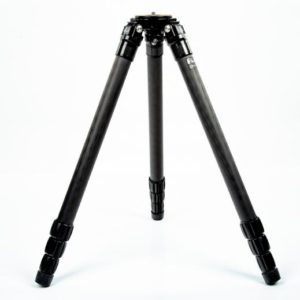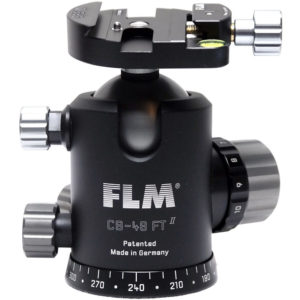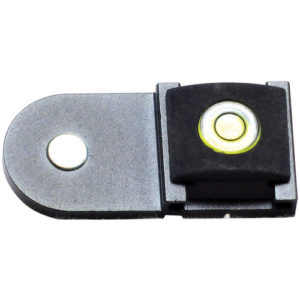Nasim Mansurov - Reviews FLM ball heads
FLM Ballhead
BY NASIM MANSUROV 70 COMMENTS
LAST UPDATED ON FEBRUARY 20, 2019
As a landscape and travel photographer, I heavily rely on tripods. After making a number of wrong purchasing decisions early on in my photography career, I realized that a solid tripod and tripod head are very important – sometimes even more important than choosing a camera or a lens. A poor tripod setup can create many headaches and really mess up images, and tripod heads play a big part of that. Many cheap tripod heads sag even after they are tightened. Some can barely hold gear and shake like crazy in wind or when they are touched. Others have poor plates and attachments, making them very frustrating to use in the field. Unfortunately, many of us go through a number of bad tripod heads before realizing that we should have gotten something solid to begin with. For the past seven years, I have been very happy with the Really Right Stuff BH-55 ballhead. In fact, after using the BH-55 for a few years, I ended up buying a few more ballheads from RRS for other needs such as travel. However, after attending a few trade shows and seeing other options from other companies, I wanted to see if there was something even better than the RRS ballheads that I have come to trust and love. I bumped into FLM at Photo Plus New York last year and after talking to the company, I decided to give their ballheads a try and see how they compare to RRS. Thanks to FLM Canada, I was able to obtain three ballheads to test, the CB-58 FTR, CB-48 FTR and CB-32 F. In this review, I will go over these three ballheads in detail and discuss their pros and cons.
A 20 minute video of the three ballheads and comparisons to RRS is provided further down in the review. Let’s first start with the full-size ballhead, the FLM CB-58 FTR.
Table of Contents
FLM CB-58 FTR
The CB-58 FTR is the biggest and the most capable full-size ballhead made by FLM, a company based out of Emmendingen, Germany that specializes on tripods, tripod heads and accessories. The professional-grade CB-58 ballhead is proudly made in Germany using high-strength, lead-free aluminum and its components are CNC-milled and then hand-polished with the highest precision to guarantee smooth movements and precise adjustments. The unique design of the CB-58 FTR incorporates a total of five different knobs that control different features of the ballhead (discussed in detail below), which is pretty unique, since most ballheads on the market typically come with two to three knobs at most. The ballhead can be purchased in a number of different clamp configurations, but the one that I received already featured the SRB-60 Arca-Swiss compatible quick release clamp. TOP ARTICLES1/5READ MOREPhotography Backup Workflow
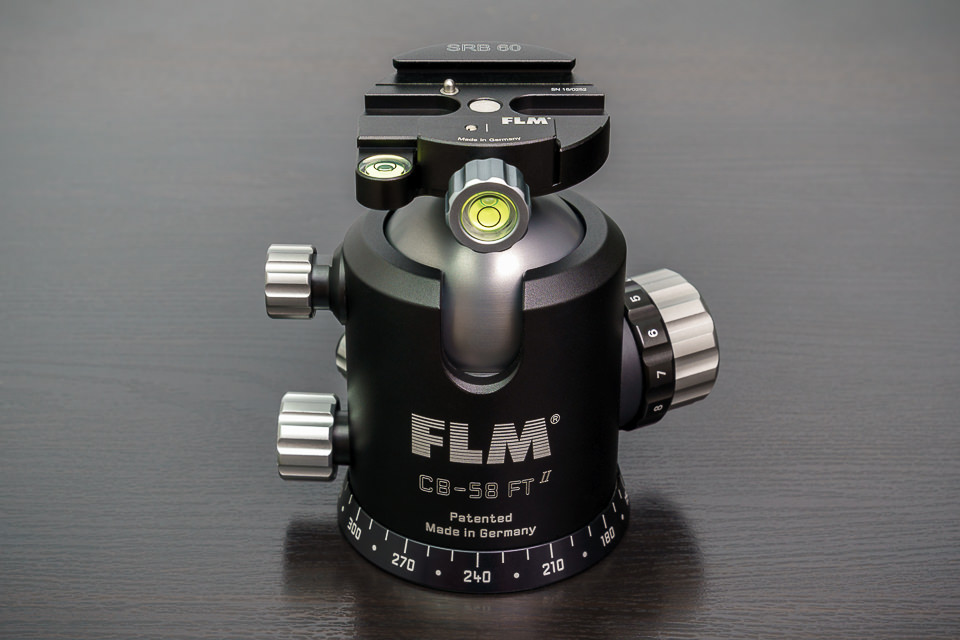
Below are the basic specifications of the CB-58 FTR ballhead:
- Model: CB-58 FTR
- Maximum Load Capacity: 55 kg / 121 lbs (60 kg / 132.3 lbs as listed on FLM)
- Center Ball Diameter: 58mm
- Dimensions: 78 x 111mm (diameter x height) / 3.07 x 4.37″
- Weight: 783 grams / 1.73 lbs
- Bottom Thread: 3/8 inches
It is a pretty big and heavy ballhead, but not as heavy as some other full-size ballheads on the market. For example, the RRS BH-55 is a bit heavier at 890 grams (although the bigger and the heavier clamp on the RRS definitely adds to the overall weight), while other ballheads like the Novoflex ClassicBall 5 II almost reach 1 kilogram of total weight without a clamp. It measures 111mm in height, which is fairly tall when compared to the RRS BH-55, which is noticeably shorter at 94mm.
The most impressive feature of the FLM CB-58 FTR is its maximum load capacity – at 55 kilograms, it is one of the most capable ballheads on the market. In comparison, the Really Right Stuff BH-55 is rated at 23 kg, less than half of what the CB-58 is capable of. Most other ballheads don’t even stand a chance, since they are rated even lower. Forget about the rating, is that number even realistic, or is it just a marketing gimmick? I had the same question and I decided to put the CB-58 through a few tests. My first test was to install a nodal slide on the ballhead, then with the ballhead mounted on a very sturdy Gitzo Systematic tripod, try to apply a lot of push / pull force on each side of the slide to see if I could force the ballhead to move. After several attempts, I gave up. All I ended up doing was moving my tripod around – the ballhead did not move even a bit. I then tried applying vertical force by moving the tripod to the ground. Again, nothing moved. My final test was to put it on the ground and try to stand on the nodal slide while holding on to a rail. All I ended up doing was making the ballhead move side to side because it was not attached to anything, but the head itself would not move. That’s pretty darn impressive! To be fair, I repeated these tests with my BH-55 and it did not move either, so my weight testing was not very conclusive. I guess without first mounting the tripod on a flat surface, it would be quite difficult to assess the true potential of the CB-58 when compared to other ballheads. But who cares really? I don’t know why anyone would want to put the load of a person on a ballhead – that’s not what these things are designed to do. Even with my BH-55 that is “only” rated at 23 kilograms, I have not had a situation where I needed more. Even when using very heavy older manual focus lenses like the Nikon 600mm f/4 IF-ED or the newer Nikon 800mm f/5.6 VR attached to a full-size Nikon D4 DSLR, I never managed to exceed 7 kilograms total, let alone 23 kg! And the CB-58 can more than double that, which is insane!
Aside from that, the CB-58 can do things that most other ballheads on the market, including ones from RRS cannot. For example, it can be locked to tilt in one direction, something I have previously only seen on the UniqBall. Another great feature is the ability to switch from smooth panning base to geared panning, which is a feature I wish every tripod had. In addition, one can rotate the base to 0° and press the “15° STOP” button to fully lock the panning base, in order to be able to quickly detach it from a tripod – a very useful feature in those situations where a ballhead can get stuck to the tripod base. These are all great features to have on a ballhead and that’s where most other ballheads on the market miss out in comparison.
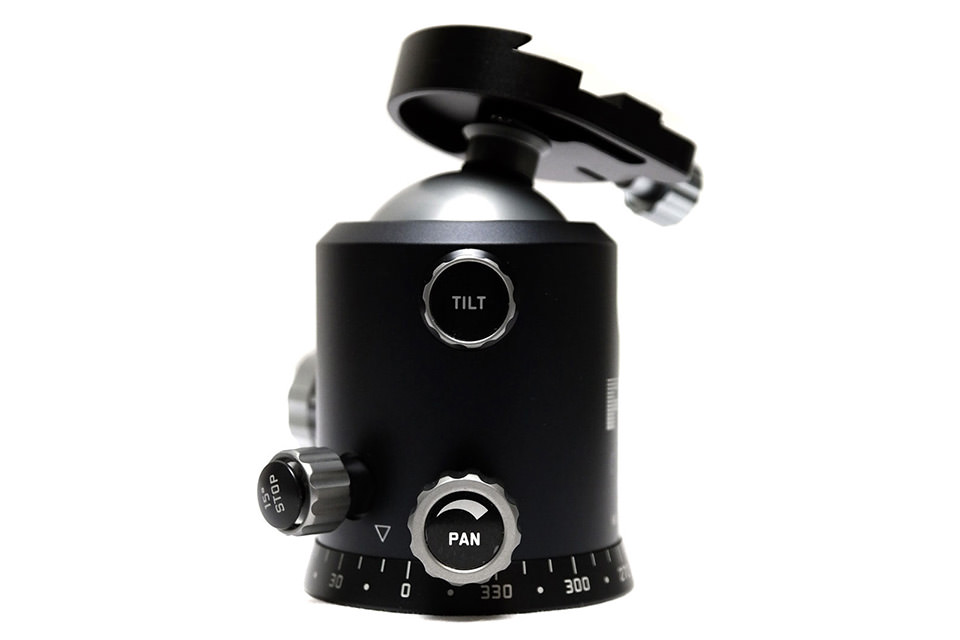
Take a look at what each knob does:
- Main Knob: to tighten / loosen the head
- Tension Knob (on top of the Main Knob): to add tension to the main knob, so that the head does not easily fall off
- Tilt Knob: to control tilting in one direction
- 15° Stop Knob: the knob controls whether the panning base is geared or not (geared panning base rotates in 15° increments). The button on top of the knob allows locking the head in 0° position for easy tripod removal
- Pan Knob: to allow base panning
As you can see, the CB-58 comes with a number of unique features that make it stand out from its competition. Most other ballheads, including my RRS BH-55 only have a few knobs to control the tension and basic panning only.
While these features are indeed very nice (I am especially a big fan of the geared panning base), I personally found two issues with the FLM CB-58, one of which is present on all FLM ballheads. First, the tilt feature is not as useful as it looks. While it could come in handy for doing things like vertical panoramas, I would not trust it to be able to handle heavy gear. The problem is, even with the tilt knob fully tightened, I could still get the head to move in other directions with enough force. So if you have heavy gear and you are thinking about using this ballhead as a gimbal, I would be extra careful – it might not be a good idea, since the setup could start falling sideways. Unlike UniqBall that can freely move in any direction, but never on the sides (making it a potential gimbal replacement), the CB-58 cannot be locked to perform a similar function.
Second, it takes many turns on the main knob to fully tighten the head, which is rather annoying – something I had a hard time getting used to. With my BH-55, a quarter of a turn on the main knob loosens or tightens the setup, which is something I am very used to. Most other tripods behave very similarly in this regard. However, with the FLM ballheads, you have to turn the main knob many times. Going from a fully loose to a fully tightened position can take as many as three full turns, which is a lot! Considering that you will be resetting your hand every half turn or so, that translates to something like 6-7 total rotations that are needed. If one needs to make quick adjustments, that process will certainly take more time in the field when compared to other ballheads. While one can somewhat restrict this with the tension knob, it still takes a few turns to fully lock the head. This problem is universal across all FLM heads, since it is designed this way. I am sure one can get used to this behavior overtime, but I certainly found it to be a bit time consuming and annoying.
These issues are discussed in detail in my video review of the three ballheads:
Overall, despite the above-mentioned issues, I found the FLM CB-58 to be one of the best ballheads I have handled so far. If you have heavy gear and you need one of the sturdiest and most reliable heads on the market, I would certainly trust the CB-58 to fit the bill. At $450 with a quick-release clamp, it has excellent value, something I would certainly recommend over most other full-size ballheads, including the RRS BH-55.
FLM CB-48 FTR
The FLM CB-48 FTR is a smaller brother of the CB-58 and it is the second biggest ballhead made by FLM. At 582 grams, it is lighter and also noticeably smaller than the CB-58, with its 65 x 99mm dimensions. It can handle less load, but not by a huge margin – still quite a bit more than what the full-size BH-55 can do! It has the same design and knobs as its bigger brother, so it is identical in its functionality, with the ability to tilt, as well as being able to do geared panning and easy tripod removal.
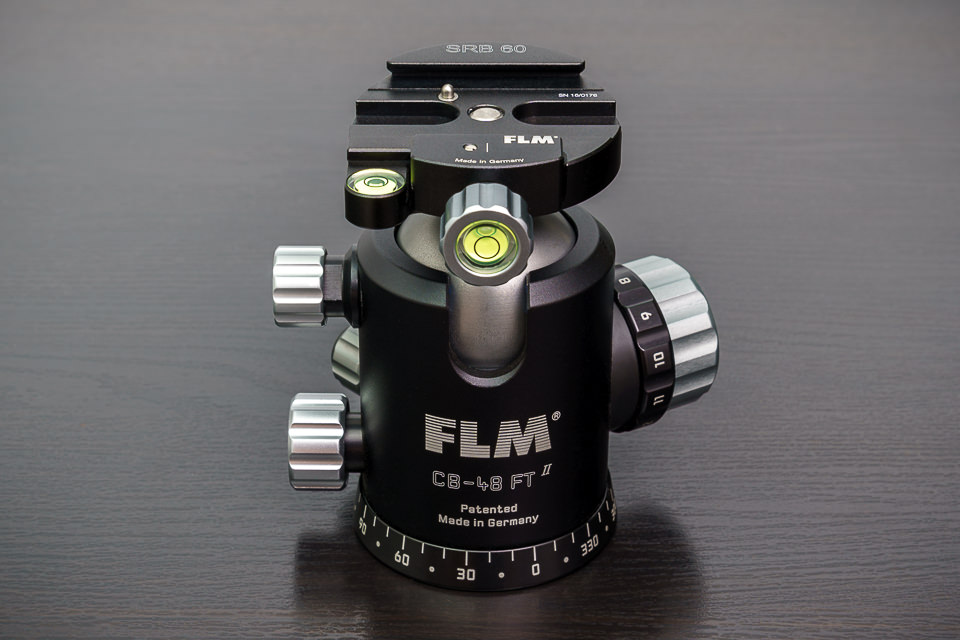
Let’s take a look at its specifications:
- Model: CB-48 FTR
- Maximum Load Capacity: 35 kg / 77 lbs (45 kg / 99 lbs as listed on FLM)
- Center Ball Diameter: 48mm
- Dimensions: 65 x 99mm (diameter x height) / 2.56 x 3.90″
- Weight: 593 grams / 1.31 lbs
- Bottom Thread: 3/8 inches
I found the listed specifications to be a bit confusing. While B&H lists maximum load capacity of 55 kg for the CB-58 and 35 kg for the CB-48, the FLM website shows the two to be 60 kg and 45 kg consecutively. I am not sure which one is more accurate, but I guess it does not matter all that much, because these ratings are pretty crazy anyway. Whether the CB-48 can handle 35 kg or 45 kg does not matter for me personally, because both are still quite a bit more than what the RRS BH-55 and most other ballheads can do.
To be honest, if I were to pick between the CB-58 and the CB-48, I would go with the latter, since it is smaller, lighter and can handle anything you throw at it. In fact, I would probably even go for the smaller CB-38 FTR model that can handle 25 kg of weight and only weighs 436 grams. Considering that all these ballheads come with identical features and knobs, why not pick the smaller and lighter one? If you have heavy gear and a full-size tripod, then perhaps the CB-48 or CB-43 would be the way to go, but for an everyday setup with a DSLR or a mirrorless camera and standard lenses, I would personally go for a smaller setup.
FLM CB-32 F
In fact, if you need a lightweight ballhead for travel, something like the CB-32 F would be potentially ideal. I requested this little guy to see how it would perform when traveling and I must say, I was pleasantly surprised by how well it performed. I mounted fairly heavy cameras on this ballhead, including a Sony A9 with the Sony 100-400mm GM lens and it handled everything I threw at it without any problems. At 311 grams, it is lighter than my RRS BH-30 and it can still handle up to 20 kg of weight compared to the 7 kg rating on the BH-30.
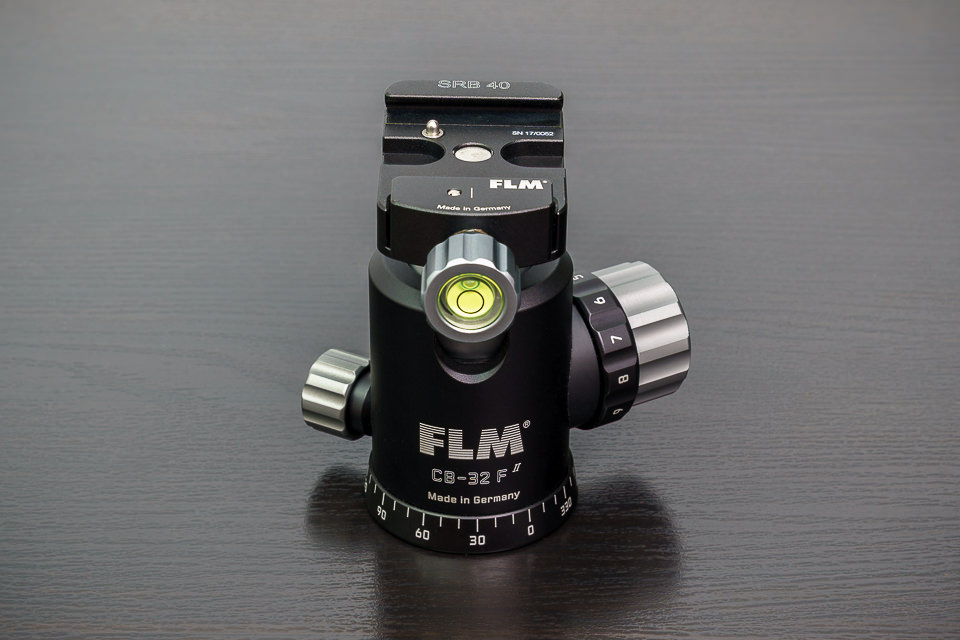
Below are the main specifications of this ballhead:
- Model: CB-32 F
- Maximum Load Capacity: 20 kg / 44.1 lbs
- Center Ball Diameter: 32mm
- Dimensions: 47 x 79mm (diameter x height) / 1.85 x 3.11″
- Weight: 311 grams / 0.69 lbs
- Bottom Thread: 3/8 inches
Obviously, all the standard knobs seen on other larger FLM ballheads would not fit on this guy, so it only comes with three of them: main, tension and panning knob. Still, even with the limited number of features, it still outdoes most other similar travel-size ballheads (including the RRS BH-30) when it comes to maximum load capacity and ability to add tension.
In addition to this model, FLM has a number of other ballheads that are even smaller, so if you are looking for something lighter, check out the CB-24 and CB-18 models.
Build Quality
When it comes to build quality, as I have already pointed out above, the FLM ballheads are made incredibly well, definitely built to last for many years to come. FLM manufactures each ballhead in Germany and aside from a few screws that they buy from other suppliers, everything else is CNC machined, then hand-polished and assembled by the company employees. This high quality is clearly visible when handling the products – every little part looks precise and nicely finished, something I cannot say about many other ballheads I have used in the past. Although I have only used these FLM ballheads for about two months, I have certainly abused them quite a bit in the field and they performed very well.
Stability
Each FLM ballhead I have tested for this review, including the smallest CB-32 F, showed amazing stability in the studio and in the field. Even when using fairly heavy equipment, I did not have any issues with sagging / drifting, which is great. Once you fully tighten the main knob, the center ball does not move at all and you can let go of your equipment without concerns of it suddenly dropping or falling. So you don’t have to worry about any play or wobbling issues with any of the FLM ballheads, which is great. In addition, I did not see any signs of shaking when touching and operating the ballheads – even the smallest CB-32 F worked extremely well, providing very secure and stable setup for the cameras I used on it.
Summary
After testing FLM ballheads, I must say that I am now a big fan! These ballheads exceeded my expectations in every way and when compared to my Really Right Stuff ballheads that I have been using for so many years, they certainly outperform them, often by a big margin. They are built extremely well, handle more load than you will ever need and have features that most other ballheads on the market do not. My favorite feature is the ability to switch from smooth panning to geared panning – something I found to be incredibly useful when shooting panoramas (I wish every tripod had this capability). I would certainly not hesitate to recommend FLM to our readers.
Where to Buy
You can purchase FLM ballheads from our trusted partner B&H Photo Video using the links below:


